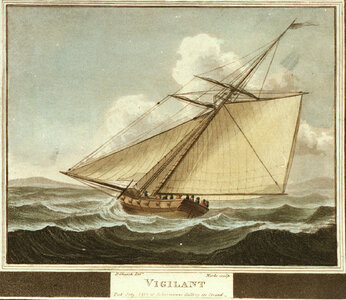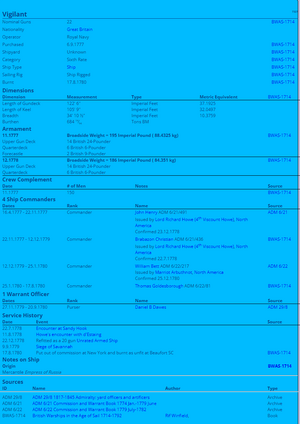however, David Syrett did a study on the Vigilant
David Syrett, distinguished professor of history at the City University of New York, died on 18 October 2004 at the age of 65. Syrett wrote scholarly monographs and edited naval documents. He never produced what might be called a popular naval history. Most naval officers and even many who have written about navies in the past may be unfamiliar with his achievements. Syrett, however, published work of very high quality in large quantity. He was the author of no fewer than six major monographs (two in press at the time of his death), seven volumes of edited documents (three in press), one major reference work, and more than 80 articles.
Syrett’s first book was Shipping and the American War 1775-83: A Study of British Transport Organization (London: University of London, 1970). This was a study of how Britain supported her armies in North America during the American Revolution. Syrett concluded that “the failure to understand the relationship between strategy, logistics, and shipping resources permeated almost every aspect of the British conduct of the war” was a major cause of Britain’s defeat. This monograph has remained the standard work on its centrally important topic.
Syrett’s next two published monographs, and a third that was unfinished at the time of his death, made up an operational history of the Royal Navy during the American Revolution. The Royal Navy in American Waters, 1775-83 (Aldershot: Scolar, 1989), The Royal Navy in European Waters during the American Revolutionary War (Columbia, SC: University of South Carolina, 1998), and an incomplete volume on naval operations in the Indian Ocean offer the greater part of an up-to-date retelling of the greatest maritime war of the 18th century, which was the main subject of Alfred Thayer Mahan’s first great book, The Influence of Sea Power upon History, and his last book, The Major Operations of the Navies in the War of American Independence. Syrett’s major strategic conclusions were similar to those of Mahan, but Syrett’s narrative was informed by a rich store of internal British policy documents that were unavailable to his distinguished predecessor, as well as by the findings of a much-enlarged secondary literature. Present- day students of this important period should rely on Syrett’s work as an introduction and guide to further inquiry.
Syrett’s two forthcoming monographs are about shipping in the Seven Years’ War, a prequel to his first book, and a biography of Admiral Sir George Brydges Rodney, the famous 18th-century British admiral.
Syrett was the first American to contribute to the distinguished British series of edited documents published by the Navy Records Society (founded in 1893). This volume was entitled The Siege and Capture of Havana 1762 (1970). It was followed by The Battle of the Atlantic and Signals Intelligence: U-Boat Situations and Trends, 1941-1945 (1998) and The Battle of the Atlantic and Signals Intelligence: U-Boat Tracking Papers, 1941-1947 (2002).
Syrett was unusual in his division of serious scholarly effort between two separated centuries, the preindustrial 18th and industrial 20th. His work, however, was unified by a common theme, that of transatlantic power projection—eastward by Britain in the 18th century, westward by the United States in the 20th. Syrett explained the British defeat in North America during the American Revolution in terms of faulty logistical administration and naval strategy. In his work on World War II he argued that the security of Allied transatlantic industrial logistics, on which the outcome of the conflict depended, resulted from the marriage of effective Anglo-American scientific and intelligence administration on the one hand and operational excellence on the other.
In all his work, Syrett’s conceptualization was based on archival research, even when dealing with matters that already had been the subject of considerable study. He believed strongly that operations could not be comprehended without careful examination of institutional context. Syrett was attentive to the degree to which strategic and operational intention was confounded by the limitations of human character, the human condition, and human institutions, as well as the play of unintended consequences. It was his sense of the periods he studied, as well as his arduous labor in the archives, that enabled him, as he did in his first major publication in the William and Mary Quarterly on Massachusetts local government during the American Revolution (July 1964), to distinguish “the difference between form and reality.” For David Syrett, historical scholarship was about serious discourse—that is, exchanges of intelligent expressions of view on things that matter. The large body of fine historical writing that he has made available to us through publication will ensure his side of the discussion will continue.





